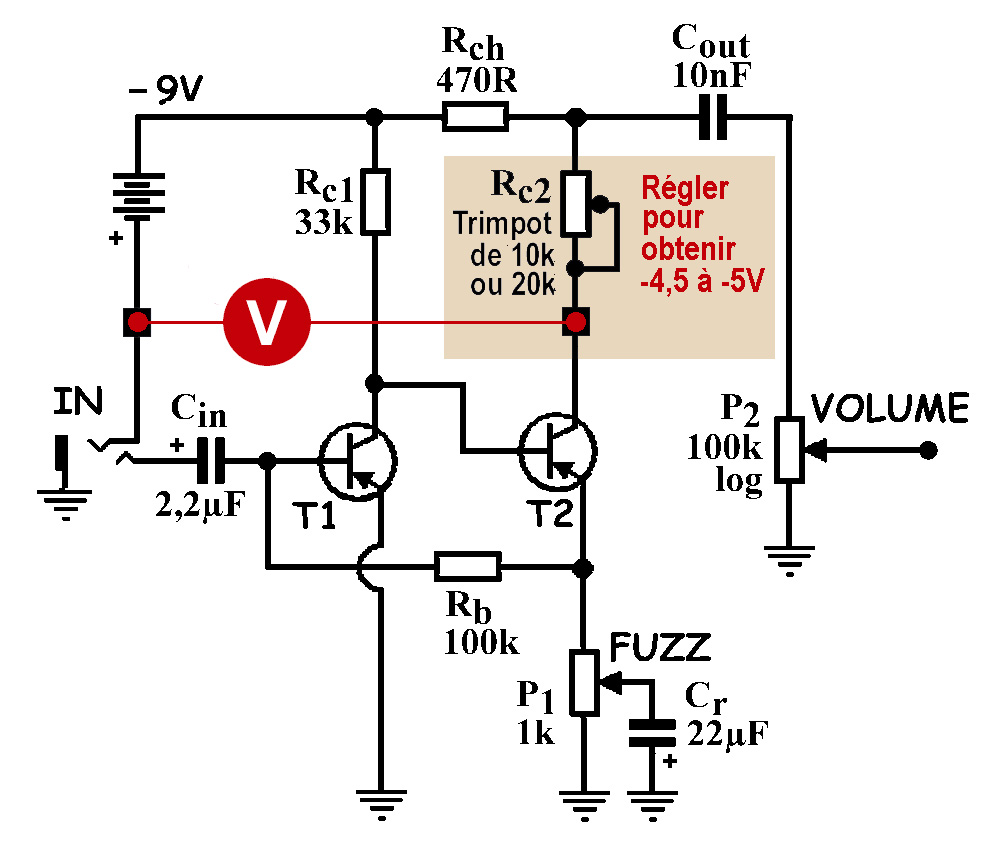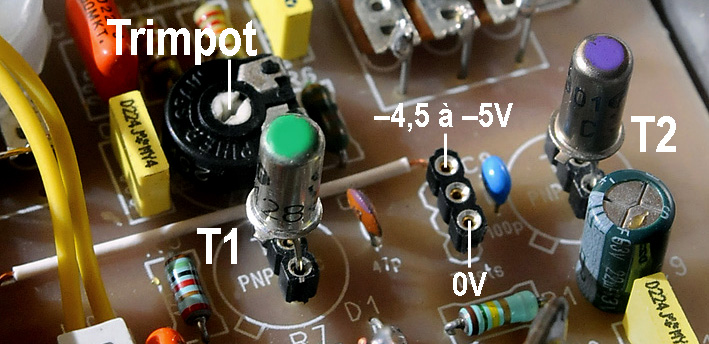In electronics, bias usually refers to a fixed DC voltage or current applied to a terminal of an electronic component such as a diode, transistor or vacuum tube in a circuit in which AC signals are also present, in order to establish proper operating conditions for the component.
This issue is evident in HiFi or PA equipment. It is the same in an Overdrive or a Fuzz : even if their output signal is saturated, it has a specific shape that must not be damaged.
This article aims to take stock, being precise both from a technical point of view and from a musical point of view… It is a bit long, but I think it is useful.
First : bias as a technical adjustment
The aim is to ensure a full signal in all cases.
Whether the signal is strong or weak, whether it starts or ends …
A poor setting cuts the start and the end of the notes.
It is sometimes creative, and those who have played with a Fuzz Factory have thus been able to experience moments of dreams … Most of the time, they must have gotten some non musical crackles : Now they know what the technical requirements of bias are!
A totally rotten bias makes the Fuzz mute.
Common causes of this mess are:
• Defective transistors.
• Mounting error, in particular transistor connections reversed.
• Forgotten or messed up solder, short circuited or cut wiring.
• Wrong valued resistors, in particular by incorrect reading of their color code.
• Misadjusted or damaged bias trimpot.
A poorly adjusted bias only transmits attacks or moments at full power.
• If there is some sound, the signals are truncate and lack sustain.
• The bottom of the notes sounds abrasive and pitiful, without sonic solidity….
But at least something comes out of the pedal :
Often, touch up some components will be enough to make the fuzz sound come back with all its substance !


Ideal technical setting of a two-transistor fuzz
Top: signal on the collector of the first transistor, with its characteristic nipple shape.
Bottom: output signal, with an optimized bias to obtain a balanced saturated signal.

Then: bias as a matter of musicality
A good bias enables the full development of the note
A guitar sound goes through 3 successive all important moments:
Attack, Sustain, Release.
A good bias highlights each of these phases:
The attack is frank and round, without blocking or heavy pops; the sustain is full and is homogeneously maintained; finally the release takes place and ends without slobber…
• The aim is that each of its moments rings fully.
Biaser la fuzz then means not being satisfied with an ordinary saturax…
• For this, it is necessary that the forms and the symmetry of the signal can breathe according to the playing of the guitarist.
• The final challenge is to let come the ideal moment when the signal takes on a unitary cyclical ratio : When its alternations have the same duration, which gives the ear a hairy but soft sound.


Input signal and on each of the two transistors, tested for three input levels:
-40dB: A low signal passes without being distorted by the fuzz, and therefore remains clear.
-30dB: A moderate signal is saturated asymmetrically but evenly.
The voltage on the second transistor presents an asymmetry, responsive to the input level, which gives a changing timbre according to the dynamics, typical of the Fuzz Face.
The nipple shape of the voltage at the first transistor may thicken, but must remain readable.
-20dB: A high level signal is fully saturated. It must tend towards a quasi symmetry, in particular on the collector of the second transistor.
The musical tweaking of the bias will make it possible to stay longer in an asymmetric and variable situation (central image), or on the contrary to make the total and symmetrical saturation appear earlier (image on the right).
Everyone to his own tastes !

Two ways to play a fuzz
One can prefer a progressive saturation.
It favors restrained effects, mate notes, chicken sounds : a playing à la Stevie Ray Vaughan or Hendrix of “Bold as love” …
Restrained passages will offer an asymmetrical and changeable saturation, where almost clean alternations blend with already hard saturated peaks.
Our ear will interpret this asymmetry as a changing mix of clear sound and fuzz sound. This is typical of Fuzz Face: the sound takes on a clearer timbre when guitar volume is lowered, and gradually becomes fuzzy and square again when the level is increased.
The most magical thing is when these two sound moments coexist …
This corresponds to a quiescent potential of -4.8 to -5.5V to be measured between the collector of the second transistor T2 and the ground.
On the contrary, one can prefer heavy playing…
A sound made of power chords and deep saturated flows…
The intermediate moments will be less subtle, because they will sound already quite fuzzy, but the sound mass will constantly have its full force.
The independent rock of the 90s updated these thick textures, like Pixies, Placebo, and other Smashing Pumpkins … Coming from the depths of the sixties, these hairy sounds have been rediscovered and are a reference in the vintage culture of Fuzz …
This corresponds to a lower no-load potential, from 4.3 to 4.8V on the collector of T2.

In practice…
The adjustment trimpot
The first fuzz had no adjustment device. They were all dissimilar, and it was a kind of lottery, because the germanium transistors are not constant from one copy to another, unless one sort them out severely … What manufacturers generally did not do, too rushed and too tight-fisted.
In fact, most of the old Fuzz were badly or not biased at all.
At its beginnings, Hendrix’s tech Roger Mayer had to buy entire lots of pedals to find one where by miracle, the transistors were well matched. He quickly understood that it was necessary to test and sort the transistors, and even better, to be able to adjust in situ this damn bias !
Manufacturers now insert an adjustable resistor (trimpot) in place of one of the fixed resistor in the diagram. This makes possible an individual adjustment of each pedal.
This trimpot is most often installed on the T2 collector. It can also be found on the T1 collector, and more rarely on the T2 emitter.

Schematic diagram of a Fuzz Face adapted with a trimpot.
The bias is checked by measuring the no-load voltage (soundless) between the collector of the second transistor and ground (the + pole of the battery).
Some manufacturers prefer to put the trimpot not in place of Rc2, which then retains its traditional value of 8.2kΩ, but instead of Rc1 of 33kΩ, then replaced by a 50kΩ trimpot. Electronically, it’s very efficient. Almost too much sometimes: you have to maneuver the trimpot carefully to obtain the desired tension on the T2 collector …
In addition, T1 working in sharp conditions, the variations of the resistance at its collector have a great influence on the grain of the fuzz, especially at moderate gain … This is why, for sound reasons, I personally prefer to use a trimpot placed in Rc2 …
It is even more critical with a trimpot on the T2 transmitter, in parallel with the Fuzz pot …

Adjust technically first
The pedal must have been powered on for 5 minutes, with no incoming signal, so as to have reached its internal cruising temperature.
1. Adjust the trimpot to measure approximately –4.5V between the collector of the 2nd transistor T2 and the + pole of the battery (or the ground of the Fuzz, it’s the same) …
• The T2 collector thus polarized around half the supply voltage will provide a full signal even at full level.
• If you do not have measure devices, you can roughly perform this step by ear by going directly to step 2.
Then adjust from the auditory point of view
2. Fuzz potentiometer set around 2.00 p.m. …
• Send an A or a D empty, without forcing, and let the note weaken slowly.
• Tweak the bias to get the whole body, the best sustain, without scratchy crunches…
3. Then play usual plans, loose or heavy, in chords or single notes.
• Fine-tuning to capture the moment when the signal is balanced: when it sounds the creamiest and best follows your playing.
As said above, some would prefer that this culminating moment only comes at a significant level of playing, or on the contrary is already present when moderately playing…
This is why the potential of the T2 collector will finally be found, according to your tastes, in the 4.3 to 5.5V range, and not necessarily on the “official” 4.5V.
4. Let it stand, and look elsewhere, leaving the fuzzbox on …
After 5 to 10 minutes, repeat the test for verifications.
So much the better if all is well, if not last touch-ups with rested ears.
• Mark the position of the trimpot with a felt point … This could be useful one day.
• One should no longer have to touch up this bias, except after replacement of the transistors …
If the creamy moment does not come, if one goes from a hoarse tone to another hoarse tone when operating the trimpot, it is because the transistors are unsuitable or defective.
• T2 has to be really rotten to be unable to work (leak> 800µA).
• T1 is much more critical: it is difficult or impossible to bias if it leaks more than 400µA, or if no corrective device has been included in the fuzz circuit …

Biasing a Like Your Face fuzzbox : The access hole to the trimpot…

Biasing devices in my LikeYourFace: the trimpot and a measurement plot.
The trimpot is also accessible from the outside for a quick “by ear” adjustment …
The transistors are one AC128 Tungsram, and one GC301C RFT. Both of us NOS, of course.

Guitar Poppa’s tips and tricks
My Fuzz have been individually biased at workshop after 10 minutes switched on.
This setting can be re-adjusted if necessary : extreme temperature, maintenance …
• An internal BIAS trimpot is placed near the center of the PCB.
• A hole on top of the box allows adjustment using a thin screwdriver from the outside.
• Engage the screwdriver, turn it gently until you feel it clicks, and adjust.
• At one end of track, the sound is clear and disappears; to the other, it becomes chipped.
It is useless to do adjust bias immediately after putting the fuzzbox on.
You must wait 10 minutes as currents and temperature are diffused in germanium crystals.
During technically setting, it is better to adjust a little up : between 4.8V and 5V.
This compensates an asymmetry in the circuit, little known to people who advise 4.5V.
(voltage on T2’s emittor resistor, for those who know…)
During musical setting, the best criterion is to get a homogeneous body and sustain.
The decision should come from the plaisure of playing the fuzz, in all ways and styles.
When a good setting has been found, one should better stick to it.
Often, guitarists have the temptation to touch the bias at the slightest discomfort feeling.
And as they do it hasty manner, nothing works no more properly.
A well designed Fuzz recovers its character each time when reconnected.
The transistors assembling and specific devices help get thermal stability, even with germanium.
Just avoid sudden temperature changes, and let time to get a cruising temperature.
Extreme conditions such as full sun or cold wind may require a temporary rebiasing.
This can be done with a screwdriver as described above.
LikeYourFace BIAS version features a potentiometer specially devoted to biasing.
Last edition, february 2021.



